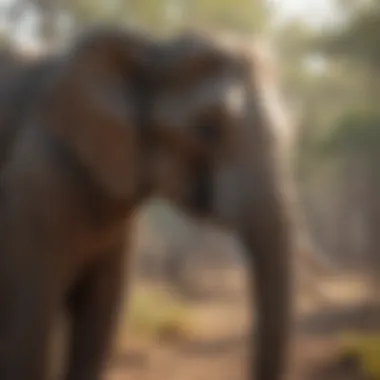How Elephants Employ Strategies for Self-Protection


Intro
Understanding how elephants protect themselves highlights their remarkable adaptability and intelligence. Elephants, as the largest land mammals, face numerous predators and challenges in their environments. This article explores various strategies they employ to ensure their survival. From physical defenses to social structures, the facets of elephant behavior are both fascinating and vital to their conservation.
Animal Overview
Common Name and Scientific Classification
Elephants belong to the family Elephantidae. The common names include the African bush elephant, African forest elephant, and Asian elephant. Their scientific classifications are as follows:
- African Bush Elephant: Loxodonta africana
- African Forest Elephant: Loxodonta cyclotis
- Asian Elephant: Elephas maximus
Physical Characteristics
Elephants are distinguished by their large ears, elongated trunks, and tusks, which are actually modified incisors. Adult African bush elephants can weigh between 4,500 to 6,800 kg and stand about 3 to 4 meters tall at the shoulder. In contrast, Asian elephants are slightly smaller, weighing up to 5,000 kg. Their skin is thick and gray, often appearing wrinkled, which aids in regulating body temperature and protecting against parasites.
Habitat and Distribution
Elephants inhabit diverse ecosystems, from savannas to forests. They are primarily found in sub-Saharan Africa and parts of Asia. African elephants are more widespread, often seen in countries like Botswana, Kenya, and South Africa. Asian elephants are found in fragmented populations across India, Sri Lanka, and parts of Southeast Asia.
Behavior and Social Structure
Communication Methods
Elephants communicate using a range of vocalizations, including rumbles and trumpets. They also use body language and touch to express emotions. Their ability to perceive infrasound, which is below the threshold of human hearing, allows them to communicate over long distances.
Social Hierarchies
Elephants live in matriarchal herds led by the oldest female. These herds typically consist of females and their young. Males tend to leave the herd upon reaching maturity. Social bonds are essential, as they provide support in raising young and protecting each other from threats.
Mating and Reproductive Behavior
Mating occurs throughout the year, but specific seasons may see increased activity. The gestation period lasts about 22 months, one of the longest in the animal kingdom. Offspring are nurtured in a supportive social environment, guided by the collective experience of the herd.
Conservation Status
Current Population Trends
Elephant populations have declined sharply in recent decades. Estimates suggest that there were around 1.3 million African elephants in the 1970s, but the number has since dropped to approximately 415,000 as of 2023. Asian elephant populations are estimated at about 40,000 to 50,000.
Threats and Challenges
Main threats to elephants include poaching for ivory, habitat loss due to agriculture and urban development, and human-wildlife conflict. These challenges make conservation efforts critical to maintaining viable populations.
Conservation Efforts and Success Stories
Various organizations work tirelessly to protect elephants. Anti-poaching measures, habitat restoration, and community engagement have shown positive results. Countries like Botswana have initiated successful policies that help safeguard elephant populations and their habitats.
“If the present trend continues, elephants may face extinction in the wild. Our efforts now are crucial for preserving these magnificent creatures.”
Prologue to Elephant Defense Mechanisms
Understanding the defense mechanisms of elephants is crucial for appreciating their role in the ecosystem. Elephants, due to their large size and intelligence, employ a range of strategies to protect themselves from predators and threats. Analyzing these mechanisms is not just an academic exercise; it reveals insights into the social behaviors and ecological interactions of these remarkable creatures.
Overview of Elephant Behavior
Elephant behavior is intricate and multi-layered. Social structures play a significant role in how elephants respond to threats. For instance, democratically led by matriarchs, herds exhibit coordinated behaviors that enhance their survival chances. The strong social bonds among herd members ensure that they watch over one another. This oversight is particularly prevalent when young calves are present.
The intelligence of elephants also manifests in their ability to learn from experiences. This adaptability allows them to develop effective strategies for recognizing and responding to potential dangers. Heuristic learning enables elephants to retain critical information about their environment, further enhancing their defensive capabilities.
Importance of Self-Protection


Self-protection in elephants is not merely about survival; it is fundamental to maintaining their populations. The pressures from predators, habitat destruction, and human encroachment make effective self-defense critical. Elephants that successfully navigate dangers contribute genes to the population. This, in turn, helps ensure sustained genetic diversity.
Moreover, their ability to protect themselves directly influences the ecosystems they inhabit. As they move through various environments, they create pathways and modify landscapes, supporting other species. Understanding how they protect themselves, therefore, has broader ecological implications.
Self-protection strategies in elephants serve as a foundation for their longevity and ecological contributions, emphasizing their role as environmental stewards.
Physical Attributes That Aid in Defense
The physical attributes of elephants are crucial for their survival in the wild. These attributes not only provide direct protection from threats but also enhance their ability to navigate complex environments. Understanding how these physical traits function can offer insights into the overall safety mechanisms employed by elephants. Some key aspects include their size, strength, tusks, and unique skin adaptations.
Size and Strength
Elephants are the largest land mammals on Earth, with adults typically reaching heights of up to 13 feet at the shoulder. Their sheer size acts as an immediate deterrent to many natural predators. The mere presence of an adult elephant can discourage would-be attackers simply due to its imposing stature. Additionally, their strength is notable. Elephants can easily uproot trees or push aside heavy vegetation, allowing them to create barriers against threats.
This strength also plays a role in intra-species confrontations. Larger elephants often assert dominance over smaller ones, showcasing a hierarchy that is well understood within herds. This social structure emphasizes the physical might that plays into survival, both individually and as a group.
Tusks and Their Role
Tusks are another significant physical adaptation. These elongated incisor teeth serve multiple purposes. First, they can be used for digging up roots or stripping bark off trees, which is essential for feeding. In defense scenarios, tusks can also become formidable weapons. Elephants may use their tusks to fend off predators or rivals, delivering powerful strikes when necessary.
Interestingly, tusks contribute to social dynamics within herds as well. They may display tusks in threat situations, showcasing their size and readiness for defense. Though primarily serving functional and protective roles, tusks are a symbol of strength among elephants.
Skin Adaptations
The thick skin of elephants is also integral to their defense mechanisms. It can be up to one inch thick in some areas, making it quite resilient against bites and scratches from predators. The skin has natural adaptations that help protect against environmental hazards, serving as a barrier against pests and harsh weather.
Furthermore, elephants use mud and water to coat their skin. This behavior not only serves to cool them down but also provides additional protection by acting as a shield against insect bites and sunburn. By using the environment to their advantage, elephants enhance their natural defenses.
"Elephants are not just strong; they are also equipped with physical features that enhance their survival odds in the wild."
Overall, these physical attributes combine to create a formidable defense system. Their size and strength discourage threats, while tusks and skin adaptations provide both offensive and defensive capabilities. These traits illustrate the evolutionary advantages that enable elephants to confront various challenges in their habitats. Through understanding these mechanisms, we gain a clearer view of how elephants thrive in an often hostile world.
Behavioral Strategies for Protection
Behavioral strategies are fundamental to how elephants maintain safety within their environment. These strategies exhibit the innate intelligence of the species and underscore their social nature. By employing effective behavioral tactics, elephants can mitigate threats from predators and human interaction. The critical aspect is the astute understanding of group dynamics, where the actions and decisions made by individuals can enhance collective security. This section delves into specific behaviors elephants exhibit to protect themselves and their young while fostering a safe community.
Herding Behavior
Roles of Matriarchs
The matriarch plays a pivotal role in elephant herds. She is often the oldest and most experienced female, possessing extensive knowledge of the terrain, water sources, and seasonal changes. This critical aspect of her role is significant to the herd's survival. The matriarch forms decisions that influence the safety of the entire group, guiding them in times of danger.
Key characteristics of matriarchs include their strong decision-making skills and social bonds with other members. They often know how to navigate threats, using their life experience to protect the herd. Their unique feature lies in their ability to communicate effectively, often using subtle cues to instill confidence and calm in younger elephants during stressful encounters.
Advantages of having a matriarch include efficient navigation towards safer areas and maintaining social cohesion. However, reliance on one individual may pose risks if the matriarch becomes incapacitated or is lost.
Protection of Young
The protection of young elephants is paramount for herd survival. Adult elephants often display heightened vigilance when calves are present. This specific aspect not only includes physical shielding but also offers emotional support, necessary for the young to thrive in a potentially hostile environment.
A key characteristic of this protective behavior is the formation of a physical barrier. Adult elephants arrange themselves around the calves during potential threats, creating a protective circle. This strategy is vital because it decreases the likelihood of predation.
The unique feature of this behavior is the coordination seen among adults—mothers and other females in the herd model protective actions collectively. While this cooperation is advantageous, it may lead to vulnerabilities if the herd is overwhelmed by multiple threats at once.
Collective Defense Tactics
Collective defense tactics demonstrate the adaptability of elephants in confronting threats. These strategies involve group coordination to deter predators or human encroachment effectively. Specific actions might include the herd making loud noises to intimidate threats or displaying aggressive body language.
A key characteristic of these tactics is the rapid communication among herd members, allowing for swift reactions to perceived dangers. Elephants can quickly form defensive formations, often responding intuitively to signals from others in the group.
The unique feature of collective defense is the ability to leverage the strengths of the group. This sense of unity has advantages, as it can often outmatch threats through sheer numbers. However, in times of poor coordination or misunderstanding of roles, the effectiveness of this strategy can wane.


Threat Display and Deterrence
Body Language Indications
Body language serves as an essential communication tool among elephants, particularly in conveying threats. Their posture and movements express a range of emotions, from aggression to placidity. Understanding these body language indications is critical in assessing the herd's state and its readiness to confront danger.
A notable characteristic is the variance in gestures that signify readiness to engage a threat. For example, ears flared out can indicate excitement or aggression, while a calm stance suggests the absence of immediate concern. The capacity to interpret these movements is beneficial, as it allows elephants to assess intent without unnecessary confrontation.
The unique feature is the silent communication it facilitates within the group, minimizing chaos during potential conflicts. This helps reduce stress among members, but there is a risk of misinterpretation, which could escalate unnecessary confrontations.
Noisemaking as a Warning
Noisemaking is another vital aspect of elephant protection strategies. Elephants produce a range of sounds, such as trumpets, rumbles, and growls, to alert their group about possible threats. This form of communication is an instinctive behavior that can effectively warn others in the vicinity.
A key characteristic of noisemaking is its effectiveness over long distances, particularly in dense environments. The roar of an elephant can serve as a clear signal that there is potential danger approaching. This communication aids in ensuring the herd remains vigilant, making it a favorable strategy in this article.
The unique feature of this behavior is its versatility, appealing to both immediate kin and distant members of the herd. However, excessive noise can attract unwanted attention from predators, making it a double-edged sword in the context of survival strategies.
Sensory Awareness in Elephants
Sensory awareness is fundamental for elephants to navigate their environment and react to potential threats. Their heightened senses of hearing and smell play a crucial role in their survival strategies. Understanding sensory awareness reveals how elephants effectively protect themselves and maintain their social structures.
Hearing and Communication
Low-Frequency Sounds
Low-frequency sounds are a significant aspect of elephant communication. Elephants utilize these deep rumbles that can travel long distances, even through the ground. This capacity allows them to communicate over various terrains and massive distances, which is beneficial for coordinating movement within the herd. The unique feature of low-frequency sounds is that they are often inaudible to many other animals, providing elephants with a distinct advantage in remaining undetected while alerting their peers.
Alert Communication Within Groups
Alert communication within groups is another critical element of how elephants ensure their safety. Elephants often communicate through a mix of vocalizations and body language. A key characteristic of this communication is its ability to convey urgency. When one elephant detects danger, it can transmit signals to others, enabling a swift collective response. This behavioral trait enhances group cohesion and promotes effective defense against threats. The benefit of this communication system lies in its efficiency; it allows for rapid information dissemination, which is vital in high-stakes situations.
Olfactory Sensitivity
Detection of Predators
Detection of predators is a crucial function of elephants' olfactory sensitivity. Elephants have a highly developed sense of smell, allowing them to detect potential threats long before they become visible. This keen olfactory ability enables them to differentiate between familiar and unfamiliar scents. The advantage this provides is significant; early detection can mean the difference between escaping danger or not. Animals like lions emit specific scents, and elephants can recognize these, prompting them to react before coming into contact with a predator.
Environmental Awareness Through Smell
Environmental awareness through smell is a remarkable feature of elephants' sensory abilities. Their sense of smell allows them to gather intricate information about their surroundings, including water sources, food, and potential dangers. This sensory input informs decisions related to habitat selection and navigation. An advantage of this strong olfactory capability is that it helps in avoiding areas that are potentially hazardous, thereby increasing their chances of survival in a changing landscape. However, relying solely on smell can sometimes be limiting in dense environments where scents may become muddled.
Elephants' sensory awareness serves as a cornerstone for their ability to protect themselves, offering insights into their complex interactions with the world around them.
Environmental Adaptations for Safety
Elephants exhibit remarkable adaptability when it comes to their environment. This adaptability is crucial for their self-protection. The choices elepphants make about their habitats and migration greatly influence their ability to avoid danger. Understanding these environmental adaptations gives insights into their survival strategies.
Habitat Selection
Avoiding Open Areas
Elephants often avoid open areas. This behavior serves clearly significant purposes. First, staying out of open spaces reduces their visibility to predators. They blend better in denser settings. A key characteristic of this behavior is the natural inclination towards cover. Elephants can often navigate through thick foliage undetected.
The unique feature of avoiding open areas is their instinct to stay hidden from threats. This strategy provides safety and allows them to access food and water. While there are advantages, it can also limit their mobility at times. Access to resources can become challenging, particularly during dry seasons.
Choosing Dense Vegetation for Cover
Choosing dense vegetation is another important strategy for elephants. This feature provides them with both cover and food. In dense areas, elephants can find trees, bushes, and grasses that serve as food sources, all while being less exposed. It also allows for easier escape from predators.
The key characteristic of dense vegetation is its ability to conceal. It gives elephants a significant advantage over threats. They can stay near safe zones until the danger passes. However, dense vegetation can sometimes harbor other threats, like humans. This encounter can pose risk and lead to conflict.


Migration Patterns
Seasonal Movements to Safer Areas
Migration is critical in elephant behavior. Seasonal movements to safer areas are a common practice. These migrations ensure access to better resources. It also allows them to evade threats such as droughts or predators. The key characteristic here is their excellent memory. Elephants recall migration routes well, adapting to environmental changes.
The unique feature of these seasonal movements is the capacity to travel large distances. This not only alleviates pressure from resource scarcity but also keeps them away from harmful encounters. However, long migrations can also be exhausting. They may encounter obstacles that make the journey more perilous than expected.
Accessing Water Sources While Evading Danger
Accessing water sources becomes crucial, especially in harsh conditions. Elephants are smart enough to find ways to reach water while minimizing risks. They often use learned pathways that offer safe passage. A key characteristic is their ability to recognize safe times for travel, often using dawn or dusk for movement when fewer threats are present.
The unique feature of accessing water safely is their keen awareness of surroundings. This allows them to adapt their routes based on the presence of potential dangers. While this strategy successfully minimizes risks, it requires elephants to navigate pressures from both climate and human activity.
Elephants' adaptability in changing environments reflects their intelligent survival strategies, highlighting the urgent need for habitat conservation.
Through these practices, elephants demonstrate that their survival is intertwined with effective environmental adaptations. Recognizing these strategies can foster better conservation efforts for their natural habitats.
Human-Elephant Interactions
Human-elephant interactions are crucial in understanding how elephants protect themselves. As the human population expands, the overlap between human territories and elephant habitats increases. This interaction presents unique challenges and opportunities for both elephants and humans. Recognizing the nuances of these relationships is essential for effective conservation efforts and improving the welfare of elephants in the wild.
Impact of Habitat Loss
Habitat loss is a significant factor that threatens elephant populations around the world. Deforestation, agricultural expansion, and urban development lead to the fragmentation of habitats. This loss reduces the space available for elephants to roam freely and compromises their natural behaviors.
Elephants depend on expansive areas for migration and access to water sources. Disrupted migration patterns can lead to increased human-elephant conflict as elephants search for food and water in human-inhabited areas.
As habitats shrink, elephants may resort to destructive behaviors that put them at risk. Understanding the impact of habitat loss is vital for formulating effective conservation strategies.
Conservation Efforts
Addressing human-elephant interactions requires practical conservation efforts. One approach focuses on involving local communities and enhancing coexistence between humans and elephants.
Community Involvement
Community involvement emphasizes local participation in conservation. Engaging the communities living near elephant habitats fosters a sense of ownership and responsibility towards wildlife. This aspect is crucial because locals are the first line of defense against poaching and habitat degradation.
By involving communities in conservation planning, they can benefit economically through eco-tourism. Additionally, raising awareness about the importance of elephants and their roles in the ecosystem encourages positive attitudes towards these animals. However, this strategy varies by region and depends on community dynamics and support systems.
Strategies for Mitigating Human-Wildlife Conflict
Another essential aspect is developing strategies to mitigate human-wildlife conflict. These strategies include education, the use of trained dogs to detect elephants, and building barriers to protect crops. The key characteristic of these strategies is their focus on preventing conflicts before they escalate.
The unique feature of such strategies is their adaptability. They can be tailored to fit the local context, making them a suitable choice for diverse environments. However, implementing them may require considerable resources and community cooperation.
Engaging communities and implementing wildlife conflict mitigation strategies are vital elements in ensuring the future of elephants and human coexistence.
In summary, understanding human-elephant interactions is fundamental for protecting both elephants and their habitats. With concerted efforts, effective communication, and community engagement, better outcomes can be achieved for both parties.
Closure: The Future of Elephant Self-Protection
As we analyze the mechanisms by which elephants protect themselves, it becomes clear that understanding these strategies is crucial for their future. Elephants face numerous threats that impact their survival. Without adequate protection and preventive measures, their populations continue to decline. Therefore, a comprehensive approach is necessary to ensure the effective self-protection of elephants in their natural habitat.
Continuing Challenges
One of the significant obstacles elephants encounter is habitat loss. Urban expansion and agricultural practices lead to the degradation of their environment. This creates challenges in finding suitable areas for foraging and nesting. Disturbances caused by human activities create stress and may sever the bond within herds, impacting their collective defense strategies. Additionally, poaching remains a critical issue. Demand for ivory and other elephant parts puts immense pressure on populations. Conservation efforts must address these challenges head-on to facilitate better outcomes for elephants.
Other concerns include climate change and its effect on migration patterns. Changing weather affects water sources and food availability. Elephants need unwavering access to these essential resources.
The Role of Education and Awareness
Education plays a vital role in elephant conservation. Increasing the awareness of local communities can lead to positive outcomes. When people understand the importance of elephants in the ecosystem, they are more likely to support conservation efforts. Elephants act as key species, shaping the environment around them, which indirectly benefits many other wildlife.
Schools and outreach programs can engage younger generations, instilling respect for wildlife. Informed communities become ambassadors for elephants, advocating for their protection. Moreover, employing technology in monitoring elephants helps gather accurate data to inform conservation strategies.
Engaging local communities fosters goodwill and encourages collaborative efforts in conservation. These methods can significantly enhance the self-protection of elephants against ongoing threats.







